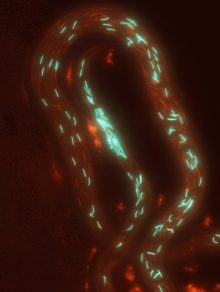The grand challenge currently facing biologists is to decipher how the information in our genome manifests itself as the biological characteristics that make up who we are. This process is referred to as establishing genotype-phenotype associations and the ability of scientists to establish these connections in a wide range of organisms has been revolutionized by the rapid increase in available genome sequences.
Associate Professor Steve Dorus, Weeden Professor Scott Pitnick and Professor John Belote, Center for Reproductive Evolution (CRE): This project involves the analysis of approximately 10,000 genes across 24 species of Drosophila spanning 65 million years of evolution.
 NSF funded research led by Associate Professor Steve Dorus, Weeden Professor Scott Pitnick and Professor John Belote, founding members of the Center for Reproductive Evolution (CRE) in the Department of Biology, and their colleagues at George Washington University are tackling this central question in post-genomic biology in relation to spermatogenesis in their model organism, the fruit fly.
NSF funded research led by Associate Professor Steve Dorus, Weeden Professor Scott Pitnick and Professor John Belote, founding members of the Center for Reproductive Evolution (CRE) in the Department of Biology, and their colleagues at George Washington University are tackling this central question in post-genomic biology in relation to spermatogenesis in their model organism, the fruit fly.
“A huge amount of resources have been dedicated to investigating how genetic variation relates to biological diversity and recent efforts have been particularly focused on variation within individual species. The best example of this is The 1000 Genomes Project, which is linking worldwide variation in the human genome to important human traits, such as disease. Our research, on the other hand, is taking advantage of the tremendous adaptive diversity between different species of fruit flies in the genus Drosophila to establish genotype-phenotype links in a comparative genomic framework”, said Prof. Dorus. He added “as evolutionary biologists, the application of comparative genomics to understanding biodiversity, especially reproductive traits that evolve rapidly, distinguish closely related species, and were potentially instrumental in the formation of new species, is especially rewarding. It is a grand fulfillment of the legacy started by Charles Darwin.”
Prof. Pitnick points out that “the research team’s current focus on sperm length may seem odd to the uninitiated, but sperm are the most rapidly evolving cell type in nearly all animal groups and their form is a critical determinant of whether or not a male’s genes make it into the next generation. Sperm length evolution has been especially dramatic in the Drosophila lineage, with species differing by more than 1800 times, from those measuring a fraction of a millimeter to those nearly 6 centimeters in length (roughly 20 times the length of an adult male fly). Research by the CRE has elucidated why sperm are so evolutionarily dynamic and has revealed the potential of sperm length evolution to serve as an engine of speciation. Understanding the genomics of sperm length is the next critical step.”
The research is made possible by the remarkable parallel computing power of OrangeGrid, computational infrastructure that has been developed at SU as part of an independently funded NSF project to ITS and Eric Sedore.
“There are several major obstacles hindering research into the evolutionary genetics of adaptation, including the complex genetic basis of many traits, the incredible volume of DNA sequence data involved and a lack of computational power to handle the required analyses. Thanks to OrangeGrid we’ve been able to adopt a very ambitious and comprehensive approach. The synergism between our research goals and the available computing resources at SU has been tremendous”, said Dr. Kirill Borziak, a post-doctoral researcher in Prof. Dorus’ lab.
This project involves the analysis of approximately 10,000 genes across 24 species of Drosophila spanning 65 million years of evolution. Multiple Bayesian analyses are required to assess correlated patterns of phenotypic and genotypic evolution for each gene individually. To date over 40,000 independent analyses have been conducted, using 5,000 processors in OrangeGrid concurrently at any given time. In total, over 10 million hours of computing have been utilized as part of this project over the past year.
Lead researchers of the project hope to expand the scope of the project to other important biological characteristics, including traits relating to longevity and female fertility.
